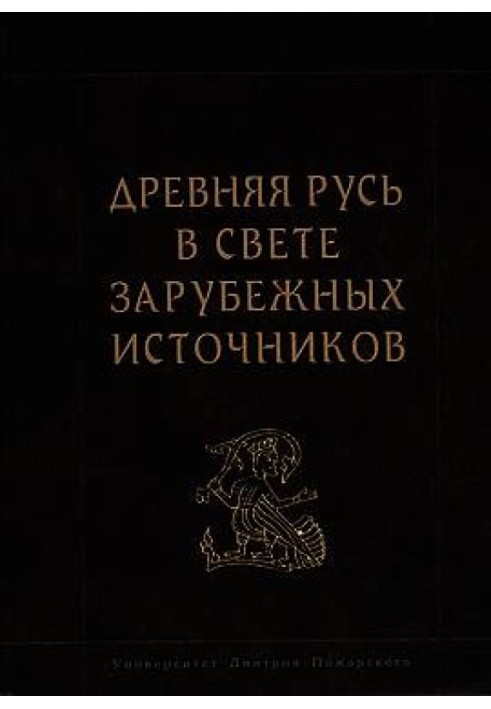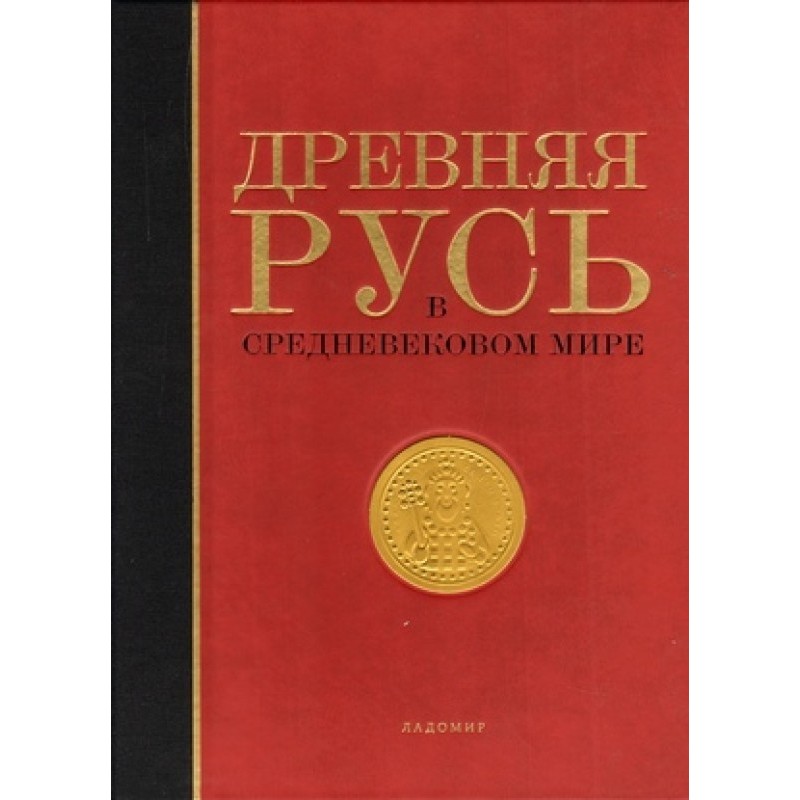Ancient Rus' in the light of foreign sources
 Instant download
Instant download
after payment (24/7)
 Wide range of formats
Wide range of formats
(for all gadgets)
 Full book
Full book
(including for Apple and Android)
The diversity, sometimes uniqueness and huge amount of information about Eastern Europe and Ancient Rus' in foreign written monuments make them a most valuable source on the history of our country, many pages of which would remain unknown if a Byzantine monk or an Arab traveler had not shown interest in them. Written in Greek, Arabic, Old Scandinavian, not all of them are known to historians of Rus'. It is not easy to use them in historical research: after all, to the eyes of a German chronicler or a Scandinavian Viking, the same phenomena of ancient Russian life were revealed from different sides. Therefore, the published book pursues three goals: to characterize the main groups of foreign sources on the history of Ancient Rus', to demonstrate the methodology for interpreting the information contained in them and, finally, present at least the most important information that they conveyed to us. A review of foreign sources about Ancient Rus' from antiquity to the mid-13th century is provided. For the first time, information contained in multi-genre monuments in Greek, Arabic, Old Scandinavian, Latin and other languages, about the social and political system, economy and trade, culture and beliefs, international relations of the Eastern Slavs and other peoples of Eastern Europe, is presented in an analytical form. humanitarian and social disciplines for higher education and secondary specialized educational institutions is prepared and published with the assistance of the Open Society Institute (Soros Foundation) as part of the Higher Education program. The views and approaches of the authors do not necessarily coincide with the position of the program. IN In particularly controversial cases, an alternative point of view is reflected in the prefaces and afterwords.
CONTENTS: Foreign sources on the history of Rus' as a subject of research. Part I. Ancient sources. Introduction1. Historical destinies of the Northern Black Sea region1.1. The ancient world on the shores of the Black Sea1.2. Local tribes of the Northern Black Sea region1.3. The appearance of the Slavs2. Types of sources3. Historiography of the study and main publications of ancient sourcesChapter 1. Ancient literary tradition about the Northern Black Sea region1.1. Introductory remarks1.2. Chronological overview of literary tradition1.2.1. Where did Odysseus sail? (Mythological stage)1.2.2. At the origins of historical and ethnogeographical science1.2.3. “Scythian story” by Herodotus 1.2.4. Athens and Bosporus in the V-IV centuries. BC1.2.5. Hellenistic sources1.2.6. What Did the Romans know about Eastern Europe?1.2.7. At the end of antiquity (sources of the 4th-5th centuries)1.2.8. The beginning of a new era: early medieval Latin sources (VI-VII centuries)1.3. General features of ancient written sourcesChapter 2. The image of Eastern Europe in antiquityChapter 3. Were the Wends Slavs? Ancient and early medieval sources about the SlavsPart II. Byzantine sources. IntroductionChapter 1. Who were the Antes? Slavs and Antes through the eyes of the Byzantines. V-VII centuries. Chapter 2. “An unknown tribe, a countless tribe... A tribe from the ends of the earth.” The name of Rus' in the Byzantine tradition of the 9th - mid-10th centuries. Chapter 3. When was Rus' baptized? A view from ByzantiumChapter 4. War and peace in Russian-Byzantine relations in the 10th - early 13th centuries.4.1. Rus' in Byzantine diplomacy: treaties between Rus' and the Greeks in the 10th century.4.2. Princess Olga in Constantinople4.3. Campaigns of Svyatoslav4.4. The last war between Rus' and Byzantium4.5. Russian military corps in Byzantium4.6. Russian principalities and Byzantium in the XII-XIII centuries. Chapter 5. Church connections between Rus' and Byzantium Chapter 6. The image of Rus' in Byzantine literature: geography and population in the XII-XIII centuries. Chapter 7. At the crossroads of cultures Part III. Eastern sources. Introduction1. The Arab Caliphate in the Medieval World2. Ways of penetration of information about Eastern Europe into the Arab-Persian world3. Main genres of eastern sources3.1. Development of geographical science3.2. Works of historical genre3.3. Epistolary monuments4. Narrative eastern sources5. History of the study and publication of eastern sources on the history of the Eastern Slavs and Ancient Russia6. Basic manuals for the study of medieval oriental sourcesChapter 1. General ideas of Eastern authors about the physical and ethnopolitical geography of Eastern EuropeChapter 2. Eastern Europe in the writings of Arab astronomers of the 9th centuryChapter 3. Early mentions of the SlavsChapter 4. Early news of the RusChapter 5. The paths of Russian merchants and Slavs to Baghdad and RayChapter 6. “Island of the Rus”Chapter 7. The first Arab traveler to Eastern Europe: Ibn FadlanChapter 8. Three “groups” of the RusChapter 9. Overseas campaigns of the RusChapter 10. Khazaria and its fallChapter 11. The Baptism of RussiaChapter 12. The Rus in the Caucasus in the 10th-12th centuries .Chapter 13. Ancient Rus' in the system of medieval states of the XII-XIII centuries.13.1. Geographical encyclopedia al-Idrisi13.2. Successors of al-Idrisi13.3. Notes of Abu Hamid al-Garnati on travels in Eastern Europe13.4. Geographical Dictionary of Yakut13.5. Russian trade in the steppe13.6. The arrival of the Mongols in EuropePart IV. Western European sources. Introduction1. Why is it important for a historian of Rus' to know Western European sources2. Several source illustrations2.1. Who are you, “Russian King Roman”? — or about the benefits of calendars2.2. Rugs or Rus' in the “Raffelstetten Customs Regulations”? 2.3. What were Princess Olga's ambassadors looking for in Germany? - or: there can never be too much textual criticism2.4. Did the Polish prince Boleslav have reasons to rejoice - or about the importance of “internal” textual criticism2.5. Ruzziau003dGraecia? - or: where does the Baltic Sea end?3. Main publications and reference literature3.1. Main collections of sources3.2. The most important reference and source study manualsChapter 1. The first mentions of Rus': IX—beginning of X centuries.1.1. “Their king is called Khakan, and the people called Ros...”: “Bertinian Annals”1.2. “Khagan of the Normans” in the dispute between two emperors1.3. “Khazars, Rus', Lukolans, Hungarians”: the peoples of Eastern Europe in the “Bavarian Geographer” 1.4. “The path from the Germans to the Khazars”: “Raffelstetten Customs Charter” 1.5. Rhos, Ruzara, Ruzzi, etc.: variants of the name Rus in Western European sources or the benefits of linguistics for historyChapter 2. Rus and Germany on the eve of the baptism of Rus2.1. “Adalbert, Bishop of Rus'”: the West and the Western Church in the politics of the Kyiv princess Olga2.2. Granddaughter of Otto the Great - wife of the Kyiv prince? Russian-German Union under Yaropolk SvyatoslavichChapter 3. Vladimir the Holy in Western European sources3.1. “Ruler of Rus', great in power and wealth”: missionary archbishop Bruno of Querfurt and Vladimir3.2. "The Great and Cruel Libertine": Vladimir in the chronicle of Thietmar of Merseburg3.3. Svyatopolk “The Damned” or Yaroslav “The Wise”? Vladimirovich strife 3.3.1. Berestey "interlude" 1017 3.3.2. Kyiv campaign of Boleslav and Svyatopolk 1018 3.4. Rex, senior, dux: the title of ancient Russian princes in Western European sourcesChapter 4. International politics of Yaroslav the Wise4.1. Novgorod prince in the struggle for Kiev4.1.1. Yaroslav and the Danish-English power of Cnut the Great4.1.2. Sons of Edmund Ironside in Rus'?4.2. Rus' and Germany: against Sack II and for Casimir I4.3. Elizabeth, Anastasia, Anna: marriage policy of Yaroslav in the 1040s4.3.1. 1042: crisis of the Russian-German alliance4.3.2. Andrew I and Anastasia (?) Yaroslavna: a turn in the Hungarian policy of Yaroslav the Wise4.3.3. Henry I and Anna YaroslavnaChapter 5. Between Poland and Germany: Western European unions of Yaroslavichs5.1. “I fornicated in foreign lands, deprived of my property”: twice exiled Izyaslav Yaroslavich5.2. Ode and Hyda: “duumvirate” of Svyatoslav and Vsevolod Yaroslavich5.3. Eupraxia Vsevolodovna: rise and fallChapter 6. International trade of Russia6.1. Regensburg as a center of continental trade with Eastern Europe6.2. Rus' and the Baltic tradeChapter 7. Russian “schismatics”: the new East European policy of the Western ChurchPart V. Scandinavian sourcesIntroduction1. Scandinavia VIII - XIII centuries. and Eastern Europe2. Genres and types of Old Norse sources2.1. Runic inscriptions2.2. Skaldic poetry2.3. Icelandic sagas2.4. Geographical literature3. Edition of Scandinavian sources and reference literatureChapter 1. The eastern half of the world through the eyes of the Scandinavians: toponymy in historical research1.1. “To the East” from Suzdal to Novgorod: about the specifics of the Old Scandinavian orientation system1.2. “Eastern part” and “Eastern path” 1.3. On the shores of the Eastern Sea1.4. Deep into Eastern Europe1.5. On the way “from the Varangians to the Greeks”1.6. Treasures of Bjarmland: literary image and historical realitiesChapter 2. In the fog of centuries: history in legends2.1.About the possessions of the Swedish kings in Austrweg2.2. Prince Igor in Scandinavian legends?2.3. Death by horseChapter 3. Scandinavians in Rus': plot stereotypes and historical realities3.1. Viking without fear and reproach3.2. How much does a mercenary cost?Chapter 4. Yaroslav the Wise in the Scandinavian tradition4.1. The marriage of Yaroslav and Ingigerd: the formation of a literary tradition4.2. Was Yaroslav the murderer of his brother?Chapter 5. The end of the Viking era5.1. Elizaveta Yaroslavna of Norway5.2. The last Viking campaign in Eastern Europe5.3. Alexander Nevsky in the Icelandic sagaChapter 6. “He sailed to Rus' with expensive goods”6.1. Trade trip of Gudleik of Gardsky to Gardariki6.2. The most ancient treaty between Rus' and Norway6.3. Gothic court and its predecessors6.4. “Grani made this hill after Karl, his comrade” Chapter 7. From paganism to true faith 7.1. The path to the east - the path to Christianity? 7.2. Pagans and Christians on the “Eastern Path”7.3. The cult of St. Olav in Novgorod
Data sheet
- Name of the Author
- Елена Мельникова Александровна
- Language
- Russian















